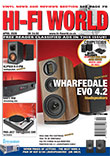Frequency response |
|
Typical generalised frequency response curves from the different sections of an AV receiver. High definition digital is mostly 96k at present, but 192k sample rate is also becoming available.
WHAT IT TELLS US Unlike stereo amplifiers, AV receivers possess many, many ways of altering frequency response, sometimes a bewildering number of ways, under the guise of signal processing schemes that supposedly ‘improve’ the sound. The processing is carried out digitally in up to three powerful DSP chips. All AV receivers with quality pretensions also provide a means of bypassing such processing. Where traditional stereo amplifiers may have a bandwidth limited to 20kHz, AV receiver amplifiers usually reach up to 100kHz, to exploit the bandwidth of 192kHz sample rate digital with an analogue bandwidth of 98kHz. There may well be arguments for and against this, but AV is its own idiom and follows a basic pattern in terms of outline audio performance, including frequency response. We measure frequency response to see if it meets AV expectations. Frequency response is limited to 20kHz by anti-alias filtering, through the analogue inputs as part of the Analogue-to-Digital (ADC) conversion process, needed to enable processing in the DSPs. This applies to all incoming signals from outside analogue sources, like cassette decks, or phono stages. The input ADCs can be bypassed by switching to Direct mode. Frequency response through the digital inputs, both S/PDIF and HDMI, is measured with up to 192kHz sample rate PCM, to check that the expected performance has been achieved, or at least usefully approached. Although a flat frequency response to 96kHz is possible receivers commonly measure -1dB from 30kHz up to 60kHz, rolling off slowly above this. Where receivers possess either on-board DSD convertors to read SACD discs HDMI linked to Blu-ray players able to play SACD, or convert DSD to PCM before conversion to analogue, we also measure SACD frequency response to check that it extends usefully above 20kHz as intended. The upper limit is 100kHz but this is rarely met. Most receivers roll off high frequencies above 35kHz or so, partly to limit supersonic noise that has the potential to burn out tweeters. Frequency response of the VHF/FM tuner is measured and this varies the most between model, according to whether their manufacturers see VHF/FM as a quality source in its own right or just a necessary addition in an already complex and crowded environment. Good VHF/FM tuner sections should possess reasonably flat (within 1dB limits) frequency response to 14kHz for a natural sounding tonal balance to be achieved. Where a phono stage is fitted we measure frequency response using an external RIAA pre-equalisation network to assess accuracy of equalisation. See Phono Stage frequency response measurement on the Vinyl LP category for more detail. 
HOW WE MEASURE IT Frequency response in the power amplifiers is measured via the multichannel inputs, using a simple manual sweep generator and an HP8903B that measures high frequency level, and an HP3561A that is able to measure accurately from 10Hz down to d.c. Stereo amplifier volume controls are commonly analogue and affected by capacitive loading, AV receiver volume controls are always digital and this limitation does not apply. We look at tone controls and graphic equalisers in real time by passing noise through the amplifier and looking at response on a spectrum analyser. This makes it quick and easy to look at what they do over the audio spectrum.
TONE CONTROL RESPONSES
Digital signals are input from both our Rohde & Schwarz UPL digital generator via S/PDIF, and Burosch and Philips (SACD) test discs, played on an Oppo Blu-ray player connected via HDMI. Frequency response of the VHF/FM section is tested using a Leader 3216 RF generator, in conjunction with a 50µS post equalisation network. Random noise is input from the Rohde & Schwarz UPL generator and measured on the FFT analyser.
Phono stages are measured for equalisation accuracy by passing random (white) noise through and external RIAA pre-equalisation network and analysing the result on the FFT analyser. See our Amplifier Test section for more detail. |







